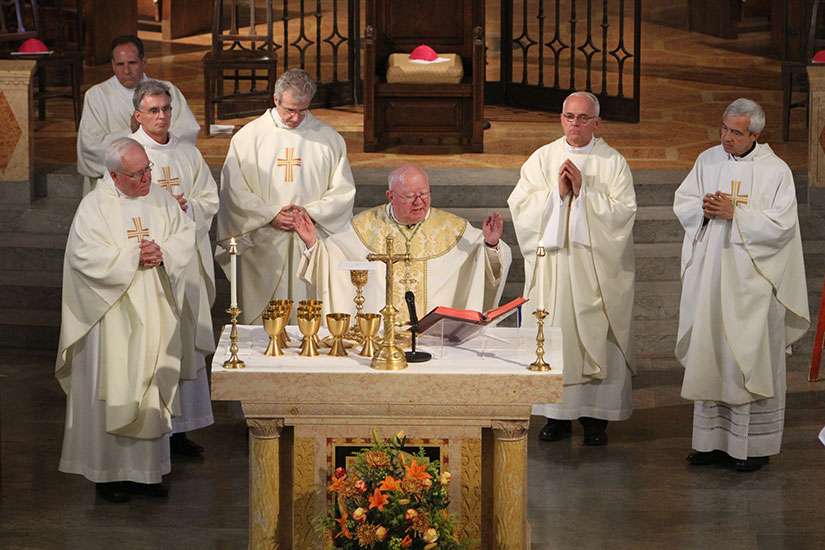Father Clifford Vogelsang, a retired priest of the Archdiocese of Indianapolis, who was ordained a year and a half before the renewal, took the modifications in stride.
Father Vogelsang's first assignment, as assistant pastor at Our Lady of the Greenwood Parish in Greenwood, continued his preparation for the renewal in the liturgy.
"I had Mass in the gym," he said. "That altar was set up to face the people."
The start of the implementation of the liturgical developments came naturally for lay Catholics like Sheri Berg, a member of St. Joan of Arc Parish in Indianapolis, who was a student at San Diego State University at the time.
"Those first liturgical changes did not have much impact on our liturgies in our small chapel," said Berg, who worked in the 1990s for the archdiocesan Office of Worship. "We had sung our hymns in English and all recited the Latin responses at Mass. Changing to some responses in English and some Latin just required a different book."
Many young priests like Father Vogelsang and seminarians at the time were prepared well for the renewal by the priestly formation they received at the former Bishop Brute Latin School in Indianapolis, an archdiocesan-operated high school seminary, and St. Meinrad Seminary and School of Theology in St. Meinrad.
Father Noah Casey, pastor of Our Lady of Lourdes Parish in Indianapolis, was a sophomore at the Latin School in 1964. He continued his priestly formation at St. Meinrad, entered St. Meinrad Archabbey and lived as a monk until becoming an archdiocesan priest in 2007.
He noted that Benedictine Archabbot Ignatius Esser, who led St. Meinrad from 1930 to 1955, was highly involved in the liturgical movement, which paved the way to much of Vatican II's renewal of worship.
"There was a spirit of (liturgical renewal) there already long preceding the council," Father Casey told The Criterion, Indianapolis' archdiocesan newspaper. "Then, when the council came, they were ready."
So was the faculty of the Latin School, led by its rector, the late Msgr. Joseph Brokhage, whom Father Casey described as "an excellent theologian and a very fine liturgist."
"When we saw where the council was going, Msgr. Brokhage started talking about it in our assemblies," Father Casey said. "Then he demonstrated it."
Msgr. Brokhage prepared the high school seminarians so well for the liturgical renewal that they took a leading role in helping to prepare priests serving in parishes across central and southern Indiana for them.
"When it finally hit and you had to have an altar facing the people, there was a team of us that he put together," Father Casey said. "We did demonstration Masses around the archdiocese for priests in the deaneries."
Looking back on those efforts, Father Casey realizes that they weren't enough.
"One weekend, you came in and the Communion rail was there, and the next weekend, without any explanation, the Communion rail was gone," he said. "It was all coming so fast that it was hard to catechize the priests and get them to assimilate it.
"In some ways, I wish that we had taken more time on catechesis and delayed the implementation a bit, not that catechesis is going to settle everything."
Promulgated Dec. 4, 1963, Vatican II's Constitution on the Sacred Liturgy ("Sacrosanctum Concilium") ordered an extensive revision of worship so that people would have a clearer sense of their own involvement in the Mass and other rites.
As it happened, though, the development of the liturgy called for by the document was implemented in a piecemeal fashion. For example, on Nov. 29, 1964, only the Scripture readings and some of the prayers of Mass were authorized to be proclaimed or prayed in the vernacular. The rest of the Mass was still prayed in Latin.
"It was a progression of changes, and they were not uniform from place to place," said Berg. "It was no wonder that many people were confused. Something that had always been consistent was that way no longer."
The implementation of some developments -- like allowing the use of the vernacular in the celebration of the Mass -- resulted in other changes.
"It certainly was the beginning of a period that was not necessarily highly thought out," said Charles Gardner, retired head of the archdiocesan Secretariat for Spiritual Life and Worship. "Everybody grabbed for things, some of it good, some of it not so good."
In addition to allowing for the use of the vernacular in the Mass, Vatican II's liturgical renewal also gave the option of the priest facing the congregation during the Mass.
"Once you did that, all of a sudden your gestures, your facial expressions and your tone voice became crucial," said Benedictine Father Columba Kelly, 84. "You have to be present to what you are doing. You're not there to entertain. You're there to lead prayer."
Father Vogelsang called this attentiveness to facial expression and vocal tone "stage presence."
"You can't just stand there and mumble everything," he said. "And an awful lot of our priests had gotten into the habit of just mumbling the Latin."
Father Vogelsang said introducing the vernacular into the Mass and changing the gestures and orientation of the celebrant "made a big difference," saying "it has forced better celebrations."
Father Robert Gilday, pastor of St. Therese of the Infant Jesus (Little Flower) Parish in Indianapolis, agreed. He said the faculty at St. Meinrad instilled in him and his fellow seminarians a value of "ars celebrandi," the art of celebrating the liturgy well.
"One of the things that you learned at St. Meinrad in particular was the importance of good liturgy," Father Gilday said. "You realize that celebrating well is important."

